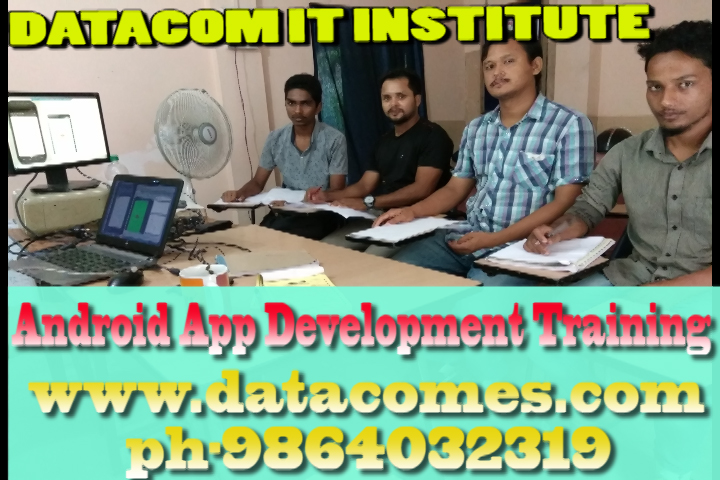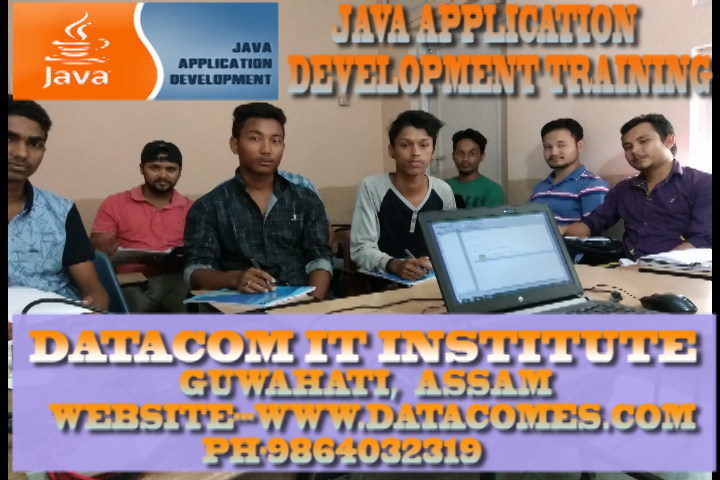
Course Name:Android Programming
Course Duration:3 months
Course Fees:12,000
Click here to see Android App Development Demo training Video
Android is for all! The most widely used language for apps development for Android platform is – Java. This Android Training program is designed keeping in mind those individuals who are not comfortable with Java and Object oriented programming concepts. During this Android Training program, we take you to a tour of Core Java where you get all the necessary Java skills which are required for developing Android applications.
 During the Android training program, first of all, the individuals are exposed to a refresher program where they go through the basics of programming, software development life cycle, oops concepts, etc. Once all the people in the class develop a common understanding of the basics, the course dives deep into Android application development specific topics.
During the Android training program, first of all, the individuals are exposed to a refresher program where they go through the basics of programming, software development life cycle, oops concepts, etc. Once all the people in the class develop a common understanding of the basics, the course dives deep into Android application development specific topics.
Objectives of the Android Training Program
The focus of our Android Training Program is to turn freshers into professionals and get you job ready. As a software professional, you will be able to appreciate the following:
> Application Development using Core Java
> Android OS Architecture
> Android Application Development Framework
> Tapping Android Mobile Hardware such as Camera, Sensors, Wi-Fi & Bluetooth
> Using Android Multimedia Framework
> Database and Web services
> End-to-End Software Development Activities
*How to develop a simple android app
Features of the Android Training Program:
> 100% Job Assistance
> In-depth coverage of Android application development layers.
> Job Counseling
> Interview preparation
> Complete knowledge on SDLC
> Knowledge & Awareness on BEST IT Practices
> Real application development
> Create your own Android App for the App store
Course Duration= 3 months
Course Fees=for detail contact 9864032319
Android Training Course Syllabus
1. History and Introduction
This chapter talks about the evolution of Android mobile platform and introduces the concepts of the Android OS architecture and its layers.
2. Setup and Installation
It explains how to download the Android SDK and start developing applications. It also introduces the Android developer tools such as Eclipse, ADT, etc.
3. Project Structure and Activity Life Cycle
Chapter 3 takes an in-depth look at the fundamental Android application components. You will be exposed to the concepts of application manifest and external resources along with Activities, their lifetimes, and their life cycles.
4. Layout Manager
You’ll learn how to create user interfaces with layouts. We explain which layout is suitable for which kind of scenario and pros and cons of each one of them.
5. Views and Menu
In an Android application, the user interface is built using Views, and menus. We teach about various views available at developers’ disposal and explain their practical use. Along with the views, we also teach how to create various menu options in Android and how to effectively use them.
6. Handling Touch Events
Views in Android respond to various events and there are more than one way to intercept the events from the user’s interaction. In this chapter you learn about the various callbacks which are required to be implemented to respond to user’s activities.
7. Animation and Drawing
All the modern applications use animation and drawing for various purposes. It is ultimately the UI which makes a difference in the world of mobile apps. Android supports two mechanisms to create simple animations : (a.) Tweened Animation (b.) Frame-by-frame Animation. We teach both these mechanisms and also take you onto drawing basics so that you can draw your custom shapes, such as graphs, circles, geometric shapes etc.
8. Style and Theme
Any discussion about UI design and creation is incomplete without the mention of style and theme. We emphasize on how to create consistent UI using common look and feel for similar views across the activities.
9. Intent
In this chapter you learn the most interesting and occupying topic of Android. Unarguably the most important component of the Android framework, Intent, is taught at length and you learn how the global message passing mechanism works. You learn implicit and explicit intent calling mechanism. You will also understand how the Intent resolution takes place in Android.
10. Broadcast Receiver
Broadcast Receiver is a component that responds to system-wide broadcast announcements. We explain how to deliver broadcasts and different ways to register broadcast receivers, set the priorities of the receivers and other aspects of the component.
11. Services
This topic deals with the essential component of Android – Service. During the course, you learn how to perform long-running operations without affecting the foreground processes such as Activities. You will learn about various states of the service, and ways to perform interprocess communication
12. Content Provider
Android framework does not provide a common data storage area that all Android packages (applications) can access. Content Provider provides an encapsulation mechanism to store and retrieve data and make it accessible to all applications. In this module, you will learn about in-built content providers. You will also learn how to write your own content provider from the scratch.
13. Resource Handling
There are various resources an application uses such as : strings, images, arrays, etc. Recommended practice is to externalize all such resources and maintain them independently. We teach you how to externalize the resources, manage various configurations for different languages, locales, screen sizes, etc.
14. Database Sqlite
Sqlite database is the de facto database supplied with Android. Android OS also contains the required libraries to manage this database. We teach you how to effectively use the database, various ways of creating it and performing CRUD operations. We cover various important classes such SqliteOpenHelper, ContentValue, etc. and the various useful methods which these classes expose.
15. Preference Management
Shared Preferences is one out of the several options to persist application data and share is across multiple activities. It stores private primitive data in key-value pairs. We explore the best practices to use the framework and effectively save and retrieve data.
16. Camera
We deal in detail with the most interesting hardware of any Android based mobile phone. We cover topics such as recording videos, taking still images, handling shutter callbacks, etc. We also discuss various mechanisms to store the raw data captured from the camera, viz. storing in Gallery or on the sdcard.
17. Sensor
Android based phones come pre-equipped with a wide variety of sensors which can measure temperature, altitude, pressure, acceleration, gravity, orientation, etc. In this topic, we discuss about all the sensors supported by Android SDK. You also learn about SensorManager and all the important call back functions which need to be tapped for recording the values coming from different sensors.
18. Wifi
In this topic, you will explore Android’s low-level communication APIs to manage and monitor Wifi communication. You will learn how to scan for hotspots, create and modify Wi-Fi configuration settings, monitor your Internet connectivity, and control and monitor Internet settings and preferences.
19. Bluetooth
Android offers APIs to manage and monitor Bluetooth device settings, to control discoverability, to discover nearby Bluetooth devices, and to use Bluetooth as a proximity-based peer-to-peer transport layer for your applications. You will learn how to interact with the local Bluetooth device and communicate with remote devices on nearby phones.
20. Webservices
The software world is all about creating, running and managing enterprise level applications. Using webservices, these functionalities are now available for different client platforms. You will deal with Android capabilities for consuming and parsing webservices. Android has the ability to handle both the SOAP based webservices as well as the RESTFUL webservices. You will learn about various tools which are used to consume and parse these webservices.
21. XML Parsing using SAX
Simple API for XML – SAX is one of most popular standard for event-based parsing of XML documents. In this topic, you will deal with the packages and APIs involved in XML parsing.
22. Telephony and SMS
During the course, you will learn to use Android’s telephony APIs to monitor mobile voice and data connections as well as incoming and outgoing calls, and to send and receive SMS messages.
You will take a look at the communication hardware by examining the telephony package for monitoring phone state and phone calls, as well as initiating calls and monitoring incoming call details. You will also learn how to send and receive SMS messages from within your applications.
23. Multimedia
Android offers a rich set of multimedia APIs capable of playing and recording a wide range of image, audio, and video formats, both locally and streamed. You’ll learn about these APIs and OpenCORE multimedia platform which can be used to create a multimedia application providing comprehensive multimedia functionality.
24. GPS and Geo Location (Location based services)
We cover location-based services which allows you to find the device’s current location. You will learn how to create map-based Activities using Google Maps. Also covered topics such as Geocoder that supports forward and reverse geocoding. You will understand the process of converting back and forth latitude/longitude values and real-world addresses.
25. Notification Service
Using notification you can alert a user of an event without interrupting their current activity. You will learn various ways of alerting the user, i.e., using status bar icon, flashing light, using ringtone and vibration. We also teach how to attach an intent to your notification that the system will initiate when the user clicks it.
26. Deployment
Once you have developed your app, you will learn how to deploy the app on a real mobile. This is done by porting the application’s apk file to the mobile device. You will learn about various apps that ease out the process of installing the app (such apps are called AppInstallers). Besides, the most important topic which is covered in this discussion is how to push your app to Android market and what all precautions you are required to take to declare your app ready for the sell.
Google Map